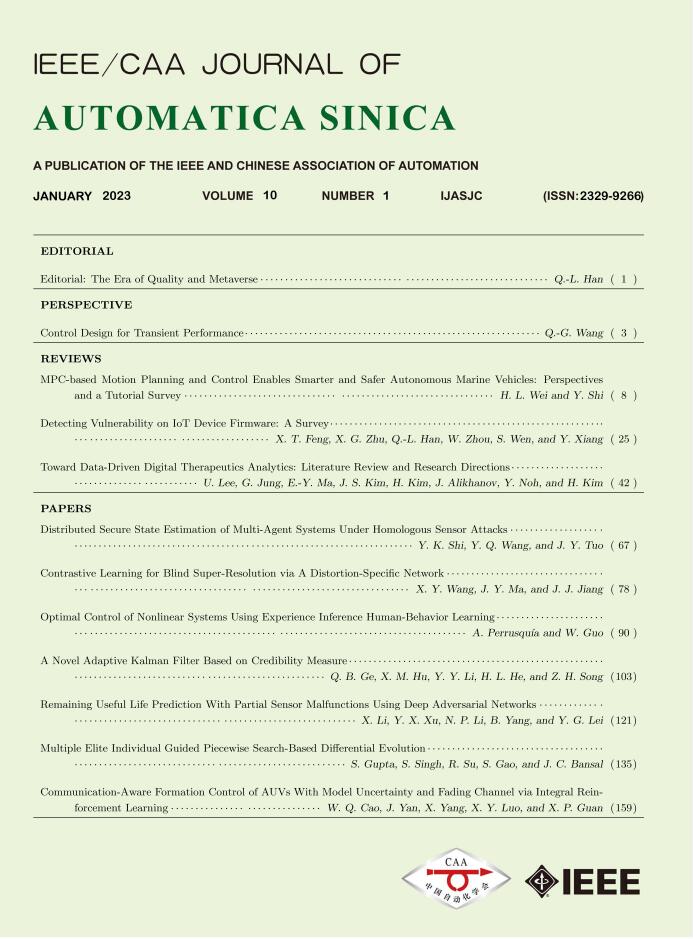 Volume 10
Issue 1
Volume 10
Issue 1
IEEE/CAA Journal of Automatica Sinica
| Citation: | G.-P. Liu, “Tracking control of multi-agent systems using a networked predictive PID tracking scheme,” IEEE/CAA J. Autom. Sinica, vol. 10, no. 1, pp. 216–225, Jan. 2023. doi: 10.1109/JAS.2023.123030 |

| [1] |
A. Kantamneni, L. E. Brown, G. Parker, and W. W. Weaver, “Survey of multi-agent systems for microgrid control,” Engineering Applications of Artificial Intelligence, vol. 45, pp. 192–203, 2015. doi: 10.1016/j.engappai.2015.07.005
|
| [2] |
B. D. Ning, Q.-L. Han, and L. Ding, “Distributed finite-time secondary frequency and voltage control for islanded microgrids with communication delays and switching topologies,” IEEE Trans. Cybernetics, vol. 51, no. 8, pp. 3988–3999, 2021. doi: 10.1109/TCYB.2020.3003690
|
| [3] |
B. D. Ning, Q.-L. Han, and L. Ding, “Distributed secondary control of AC microgrids with external disturbances and directed communication topologies: A full-order sliding-mode approach,” IEEE/CAA J. Autom. Sinica, vol. 8, no. 3, pp. 554–464, Mar. 2021. doi: 10.1109/JAS.2020.1003315
|
| [4] |
Z. Y. Xia, J. Du, J. J. Wang, C. X. Jiang, Y. Ren, G. Li, and Z. Han, “Multi-agent reinforcement learning aided intelligent UAV swarm for target tracking,” IEEE Trans. Vehicular Technology, vol. 71, no. 1, pp. 931–945, 2022. doi: 10.1109/TVT.2021.3129504
|
| [5] |
L. Ma, Y.-L. Wang, and Q.-L. Han, “Cooperative target tracking of multiple autonomous surface vehicles under switching interaction topologies,” IEEE/CAA J. Autom. Sinica, 2022. DOI: 10.1109/JAS.2022.105509.
|
| [6] |
X. H. Ge, S. Y. Xiao, Q.-L. Han, X.-M. Zhang, and D. R. Ding, “Dynamic event-triggered scheduling and platooning control co-design for automated vehicles over vehicular ad-hoc networks,” IEEE/CAA J. Autom. Sinica, vol. 9, no. 1, pp. 31–46, Jan. 2022. doi: 10.1109/JAS.2021.1004060
|
| [7] |
X. H. Ge, Q.-L. Han, J. Wang and X.-M. Zhang, “A scalable adaptive approach to multi-vehicle formation control with obstacle avoidance,” IEEE/CAA J. Autom. Sinica, vol. 9, no. 6, pp. 990–1004, Jan. 2022.
|
| [8] |
S. Y. Zhao, Z. H. Li, and Z. T. Ding, “Bearing-only formation tracking control of multiagent systems,” IEEE Trans. Autom. Control, vol. 64, no. 11, pp. 4541–4554, Nov. 2019. doi: 10.1109/TAC.2019.2903290
|
| [9] |
J. K. Ni, P. Shi, Y. Zhao, and Z. H. Wu, “Fixed-time output consensus tracking for high-order multi-agent systems with directed network topology and packet dropout,” IEEE/CAA J. Autom. Sinica, vol. 8, no. 4, pp. 817–836, Apr. 2021. doi: 10.1109/JAS.2021.1003916
|
| [10] |
J. Liu, Y. B. Wu, M. W. Sun, and C. Y. Sun, “Fixed-time cooperative tracking for delayed disturbed multi-agent systems under dynamic event-triggered control,” IEEE/CAA J. Autom. Sinica, vol. 9, no. 5, pp. 930–933, May 2022. doi: 10.1109/JAS.2022.105503
|
| [11] |
B. Niu, J. D. Liu, D. Wang, X. D. Zhao, and H. Q. Wang, “Adaptive decentralized asymptotic tracking control for large-scale nonlinear systems with unknown strong interconnections,” IEEE/CAA J. Autom. Sinica, vol. 9, no. 1, pp. 173–186, Jan. 2022. doi: 10.1109/JAS.2021.1004246
|
| [12] |
Z. Y. Zuo, C. J. Liu, Q.-L. Han, and J. W. Song, “Unmanned aerial vehicles: Control methods and future challenges,” IEEE/CAA J. Autom. Sinica, vol. 9, no. 4, pp. 601–614, Apr. 2022. doi: 10.1109/JAS.2022.105410
|
| [13] |
B. Kaviarasan, O. M. Kwon, M. J. Park, and R. Sakthivel, “Stochastic faulty estimator-based non-fragile tracking controller for multi-agent systems with communication delay,” Applied Mathematics and Computation, vol. 392, p. 125704, Mar. 2021.
|
| [14] |
G. W. Dong, H. Y. Li, H. Ma, and R. Q. Lu, “Finite-time consensus tracking neural network FTC of multi-agent systems,” IEEE Trans. Neural Networks and Learning Systems, vol. 32, no. 2, pp. 653–662, Feb. 2021. doi: 10.1109/TNNLS.2020.2978898
|
| [15] |
W. Wang, C. Y. Wen, and J. S. Huang, “Distributed adaptive asymptotically consensus tracking control of nonlinear multi-agent systems with unknown parameters and uncertain disturbances,” Automatica, vol. 77, pp. 133–142, Mar. 2017. doi: 10.1016/j.automatica.2016.11.019
|
| [16] |
X. W. Dong, Y. Zhou, Z. Ren, and Y. S. Zhong, “Time-varying formation tracking for second-order multi-agent systems subjected to switching topologies with application to quadrotor formation flying,” IEEE Trans. Industrial Electronics, vol. 64, no. 6, pp. 5014–5024, Jun. 2017. doi: 10.1109/TIE.2016.2593656
|
| [17] |
F. Chen and W. Ren, “On the control of multi-agent systems: A survey,” Foundations and Trends in Systems and Control, vol. 6, no. 4, pp. 339–499, Jul. 2019. doi: 10.1561/2600000019
|
| [18] |
X.-M. Zhang, Q.-L. Han, X. H. Ge, D. R. Ding, L. Ding, D. Yue, and C. Peng, “Networked control systems: A survey of trends and techniques,” IEEE/CAA J. Autom. Sinica, vol. 7, no. 1, pp. 1–17, Jan. 2020. doi: 10.1109/JAS.2019.1911861
|
| [19] |
G. P. Liu, “Consensus and stability analysis of networked multi-agent predictive control,” IEEE Trans. Cybernetics, vol. 47, no. 4, pp. 1114–1119, Apr. 2017. doi: 10.1109/TCYB.2016.2535126
|
| [20] |
D. L. Chen and G. P. Liu, “Coordinated path-following control for multiple autonomous vehicles with communication time delays,” IEEE Trans. Control Systems Technology, vol. 28, no. 5, pp. 2005–2012, May 2020. doi: 10.1109/TCST.2019.2921262
|
| [21] |
G. P. Liu, “Coordinated control of networked multi-agent systems via distributed cloud computing using multi-step state predictors,” IEEE Trans. Cybernetics, vol. 52, no. 2, pp. 810–820, Feb. 2022. doi: 10.1109/TCYB.2020.2985043
|
| [22] |
G. P. Liu, “Predictive control of networked nonlinear multi-agent systems with communication constraints,” IEEE Trans. Systems,Man,and Cybernetics: Systems, vol. 50, no. 11, pp. 4447–4457, Nov. 2020. doi: 10.1109/TSMC.2018.2853126
|
| [23] |
G. P. Liu, “Networked learning predictive control of nonlinear cyber-physical systems,” J. Systems Science and Complexity, vol. 33, no. 6, pp. 1719–1732, 2020.
|
| [24] |
Y. Yu, G. P. Liu, H. Xiao, and W. S. Hu, “Design of networked secure and real-time control based on blockchain techniques,” IEEE Trans. Industrial Electronics, vol. 69, no. 4, pp. 4096–4106, Apr. 2022. doi: 10.1109/TIE.2021.3071705
|
| [25] |
G. P. Liu, “Coordination of networked nonlinear multi-agents using a high order fully-actuated predictive control strategy,” IEEE/CAA J. Autom. Sinica, vol. 9, no. 4, pp. 615–623, Apr. 2022. doi: 10.1109/JAS.2022.105449
|